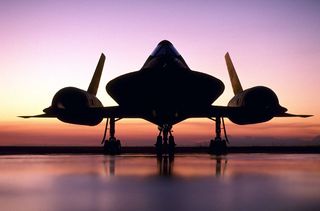Faster than a speeding bullet, the retired SR-71 Blackbird can still turn heads as a Cold War spy plane designed for flying high and fast beyond danger. The ultimate flying speed demon not only served the U.S. military's needs for decades, but also shattered speed and altitude records for manned air-breathing jet aircraft.
The SR-71 regularly flew missions at speeds beyond 2,000 mph (Mach 3) and could survey more than 100,000 square miles of the Earth's surface per hour from a height of 80,000 feet (15 miles). Such extreme operating conditions allowed the aircraft to safely avoid interceptor fighter jets or missiles, but also forced the two-person crew to wear astronaut-style suits in case of loss of cabin pressure.
Such extreme performance capabilities allowed an SR-71 to set two world records on July 28, 1976. The aircraft flew at just over 2,193 mph and at a height of about 85,069 feet.
Extreme design
Two turbine engines designed to run constantly in afterburner mode boosted the aircraft to its supersonic speeds. The aircraft manufacturer, Lockheed Martin, initially wanted the SR-71 to use liquid hydrogen as fuel — similar to the space shuttle's main engines — but abandoned the idea because it would have required huge amounts of fuel.
Lockheed Martin's Skunk Works division built stealth technology into the SR-71 by shaping its sleek airframe to reflect very little radar energy. The results proved partially successful.

The aircraft was also covered with a special black paint to absorb radar, radiate excess heat and to camouflage the aircraft against dark skies — a feature that inspired Air Force to give it the official "Blackbird" name.
Titanium skin helped protect the aircraft's aluminum airframe from the intense heat of supersonic flight. Temperatures ranged from 450 degrees F (232 C) near the back part of the aircraft to 950 degrees F (510 C) near the engine exhaust. The cockpit had special heat-resistant glass to withstand surface temperatures of 640 degrees F (338 C).
Birth and retirement
Lockheed Martin first proposed the idea of the SR-71 in the 1950s as a replacement for the slower U-2 spy aircraft. The first version of what would become the Blackbird, the A-12, flew its first surveillance mission with CIA pilots over North Vietnam in 1967.
The U.S. Air Force also wanted an interceptor fighter jet version that led to Lockheed Martin building three YF-12A aircraft, but two crashed during testing. Lockheed Martin eventually proposed a version designed for doing reconnaissance in the aftermath of a nuclear strike — the design that became the SR-71.
The SR-71's first flight test in 1964 eventually led to operational missions in January 1966. Blackbird crews ended up logging 2,801 hours of flight time during the aircraft's 24-year service.
Growing use of satellites for space surveillance and the growing danger of more effective air defenses eventually convinced the Air Force to end SR-71 operations in January 1990. The U.S. Congress attempted to revive the program in 1995 over the protests of military leaders, but budget disputes finally put that idea to rest.
NASA held onto three versions of the SR-71 for high-speed science projects and used them until 1999.
No comments:
Post a Comment